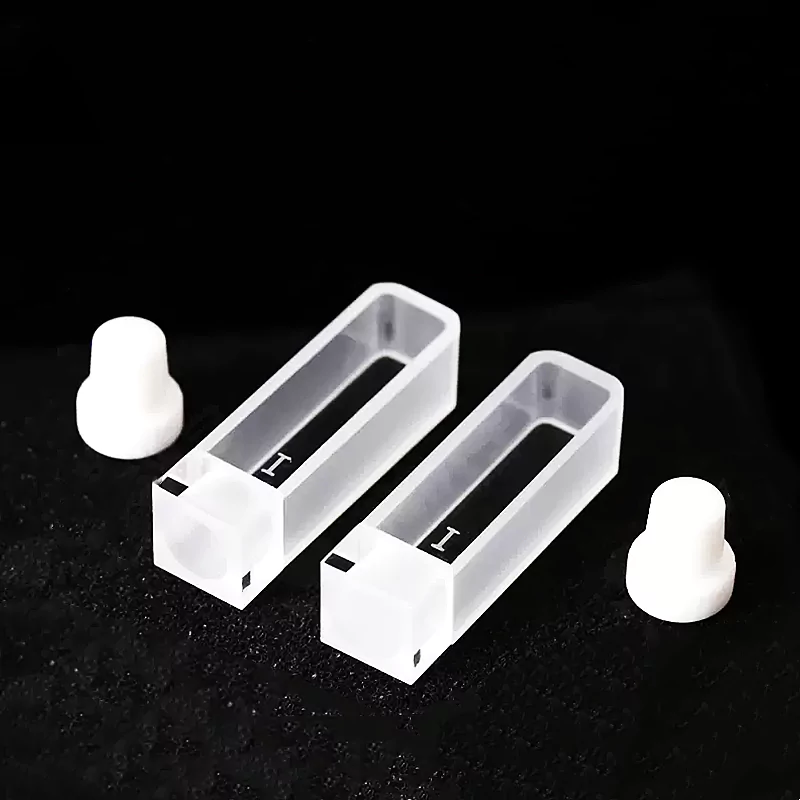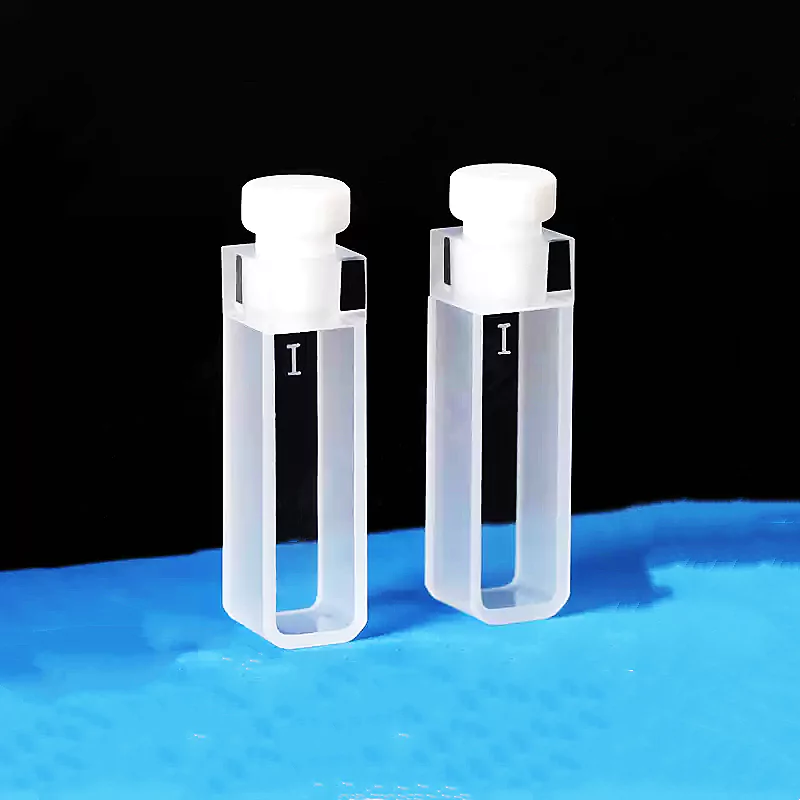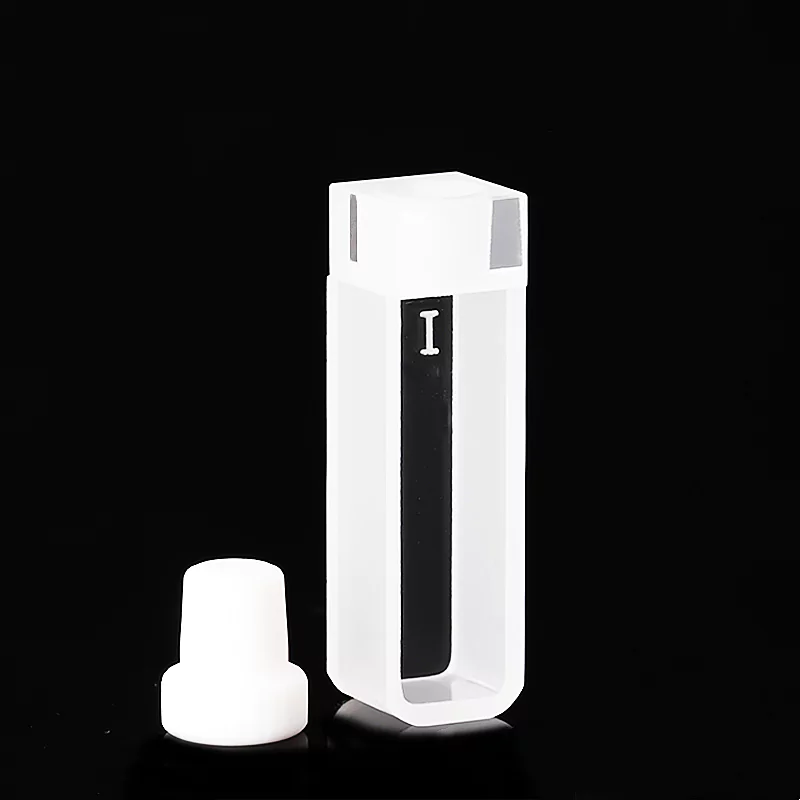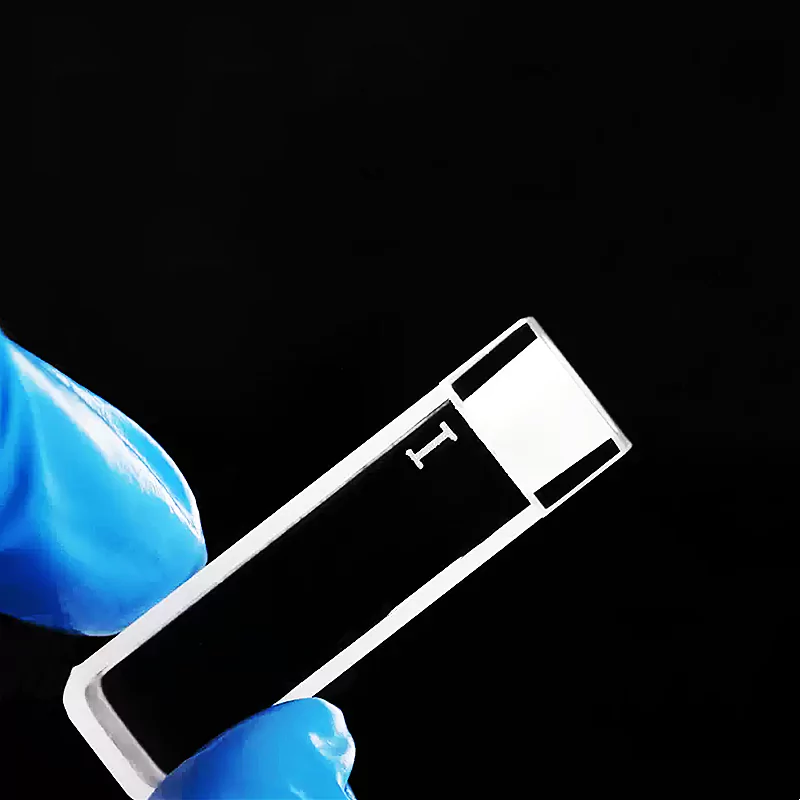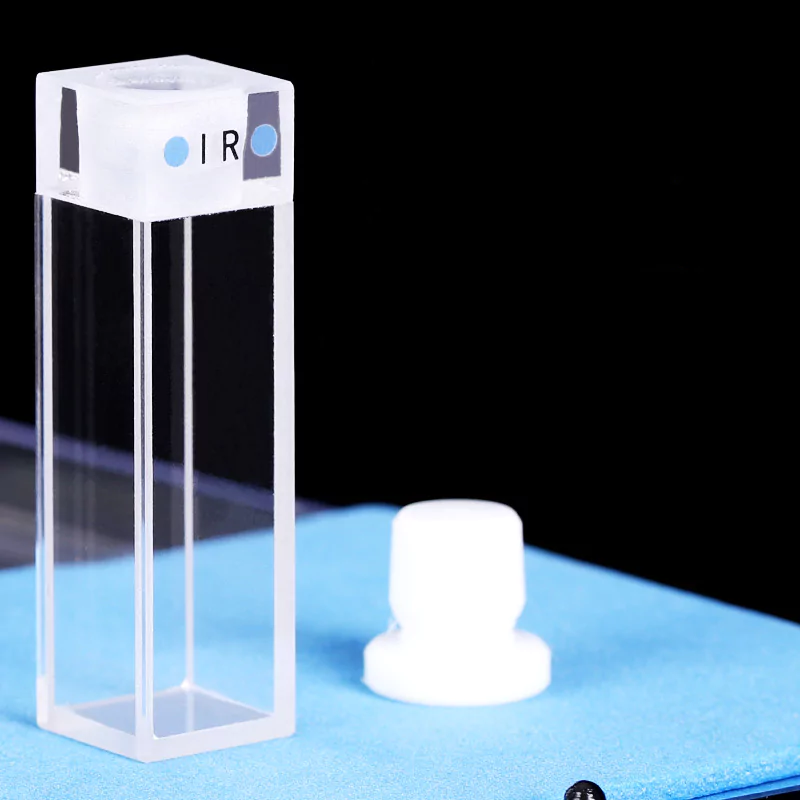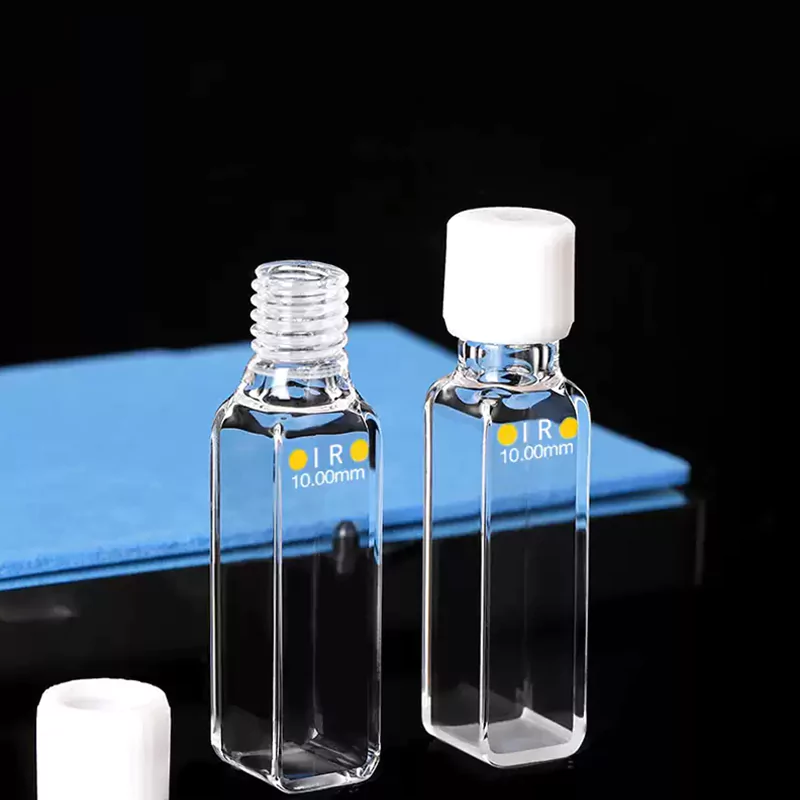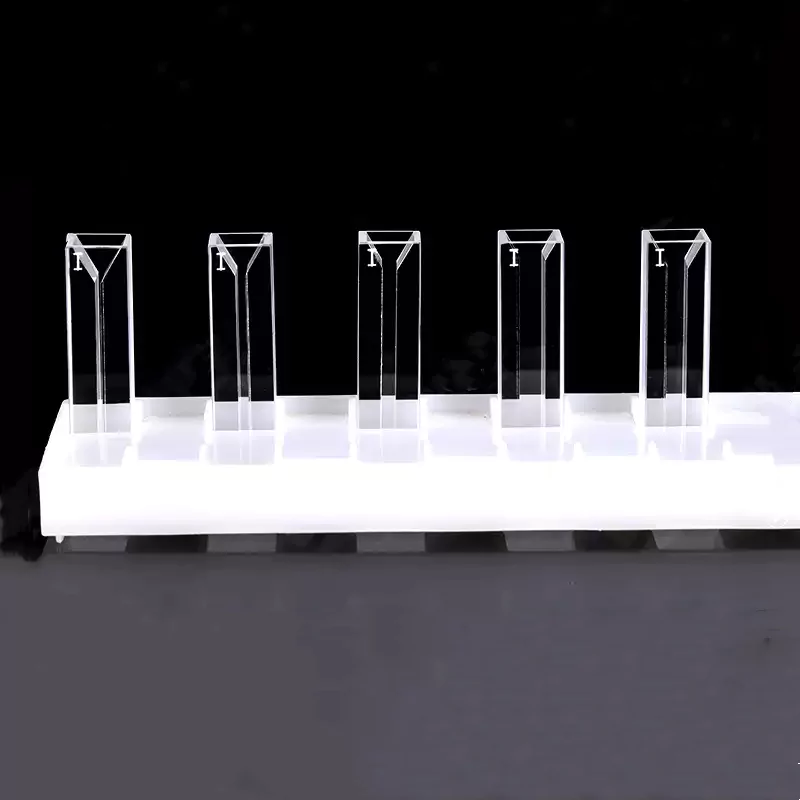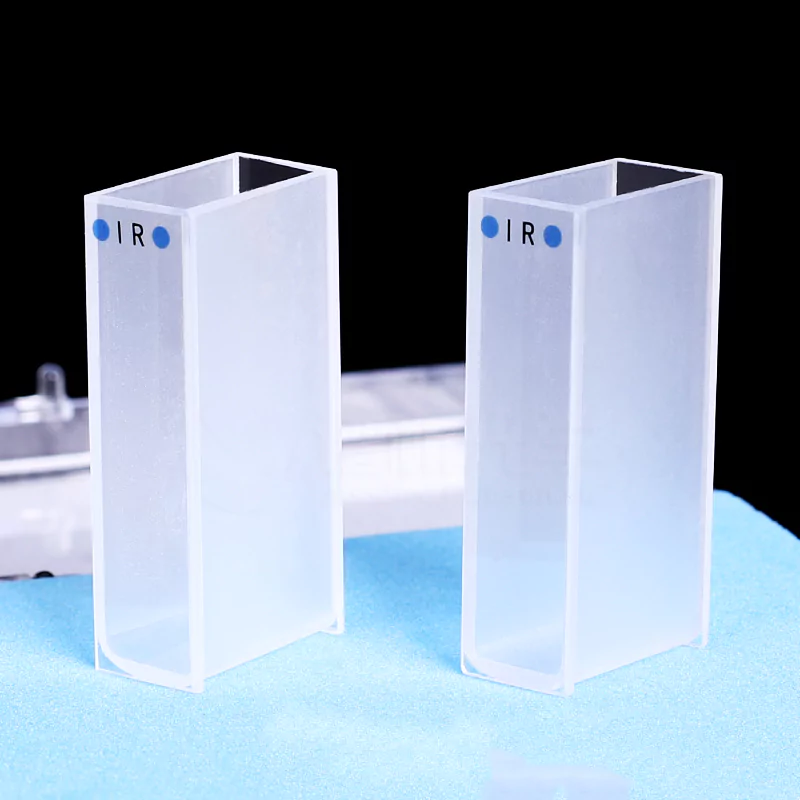- Home
- /
- Types
- /
- Quartz Cuvette
- /
- Quartz IR Cuvette
- /
- Precision Sealed Quartz IR...
Precision Sealed Quartz IR Cuvette for FTIR and Infrared Spectroscopy Labs -TOQUARTZ®
Features of Sealed Quartz IR Cuvette
TOQUARTZ® Sealed Quartz IR Cuvette combines precision optical properties with superior material characteristics to deliver reliable infrared spectroscopy results. Manufactured from high-purity fused quartz, these cuvettes offer exceptional chemical, thermal, and optical properties for demanding laboratory applications.
Precision-Engineered Sealing
Creates a hermetic seal to prevent sample evaporation, ensuring reliable analysis of volatile compounds.
High-Purity Material
≥99.98% SiO₂ purity(max. up to 99.995%) ensures exceptional optical clarity and chemical stability for accurate spectroscopic results.
Wide Spectral Range
Exceptional transmission from 260nm to 3500nm with transmittance >80%, ideal for both UV and infrared applications.
Chemical Resistance
Resistant to most acids, bases, and organic solvents, ensuring durability and longevity even with aggressive samples.

- Resistant to acids and alkalis(except HP)
- Temperature resistance up to 1100°C
- Compatible with all standard FTIR instruments
Technical Specifications & Dimensions of Sealed Quartz IR Cuvette
Technical Specifications
| Property | Specification |
| 1. Physical Properties | |
| Material | High-purity fused quartz |
| Density | 2.2 g/cm³ |
| Fracture Modulus | ≥350 MPa |
| Thermal Conductivity | 120-160 W/m·K |
| Thermal Expansion Coefficient | 5.5×10⁻⁷ /°C |
| 2. Chemical Properties | |
| Material Purity | ≥99.98% (up to 99.995%) |
| Chemical Resistance | Excellent (acids, alkalis) |
| OH Content | <30 ppm |
| pH Range | 1-14 |
| Water Absorption | Nil |
| 3. Optical Properties | |
| Transmission Range | 260-3500nm |
| Transmittance | >80% (paired testing) |
| Refractive Index (589.3nm) | 1.46 at 589.3nm |
Size Chart
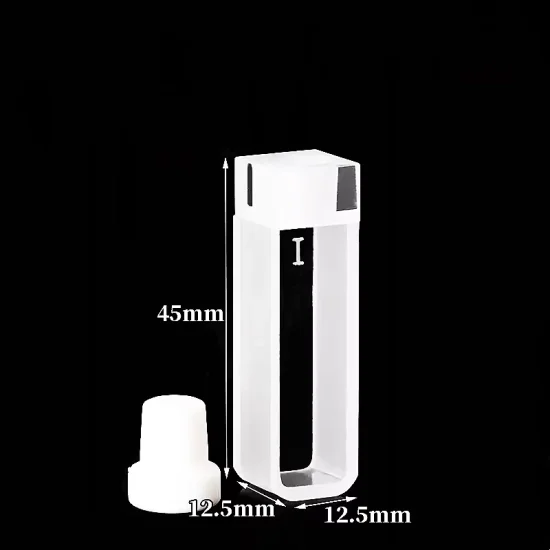
| Model | Description | Wavelength | Path Length | Volume | Transmittance | Outline Dimension |
| AT-BSM-2002-1 | 3.5mlSealed Quartz IR Cuvette for Infrared Spectroscopy | 260nm-3500nm | 10mm | 3.5ml | >80% (Paired Testing) | 12.5×12.5x45mm |
Overcoming Critical Challenges in Infrared Spectroscopy Analysis with TOQUARTZ® Sealed Quartz IR Cuvettes
Sealed Quartz IR Cuvette in VOCs Detection for Environmental Monitoring
Key Advantages
-
VOC retention rate >98% over 30 minutes
Paired PTFE-sealed cuvettes maintain >98% sample mass for VOCs like benzene and toluene during FTIR scans. -
0.2% concentration deviation in 20°C–25°C lab conditions
Sealed design ensures minimal concentration drift in ambient temperature fluctuations during analysis. -
Compatible with EPA Method 8260 FTIR protocols
Supports trace-level VOC detection in compliance with US EPA standards for water and air testing.
TOQUARTZ® solution
A German environmental lab reported a 12% VOC loss during FTIR testing using open-top cuvettes, leading to regulatory non-compliance under EU Directive 2008/50/EC. After switching to TOQUARTZ® sealed IR cuvettes, VOC retention improved to >98% over 30 minutes, enabling accurate quantification of benzene and chlorinated solvents at sub-ppm levels, and reducing retesting frequency by 40%.
Sealed Quartz IR Cuvette in Solvent-Sensitive Pharmaceutical FTIR Testing
Key Advantages
-
Solvent mass loss <1.5% in 15 min scan
Sealed cuvettes prevent rapid evaporation of methanol and acetone under IR beam exposure. -
Maintains ±0.3% concentration stability for APIs
Ensures consistent analyte-to-solvent ratio during FTIR fingerprinting of pharmaceutical compounds. -
Validated for USP <197K> FTIR identity testing
Meets pharmaceutical FTIR method validation criteria for volatile solvent systems.
TOQUARTZ® solution
A US-based pharmaceutical R&D team experienced 8–10% solvent loss during FTIR analysis of API solutions in ethanol, causing spectral shifts and failed reproducibility in USP <197K> validation. After adopting TOQUARTZ® sealed IR cuvettes, solvent mass loss dropped below 1.5%, and API concentration remained within ±0.3%, enabling successful method validation and reducing batch rejection risk.
Sealed Quartz IR Cuvette in Reactive Gas Analysis for Chemical Process Monitoring
Key Advantages
-
Gas leakage rate <0.05 mL/min under 1 atm
PTFE-sealed cuvettes maintain stable gas-phase concentrations for over 20 minutes. -
Corrosion resistance validated for SO₂ and HCl exposure
Quartz + PTFE combination withstands acidic gas environments without degradation. -
Enables kinetic FTIR tracking with ±2% signal stability
Supports real-time monitoring of gas-phase reactions with minimal signal drift.
TOQUARTZ® solution
A Japanese catalyst research institute faced inconsistent FTIR readings when analyzing NH₃ and SO₂ due to gas leakage from standard cuvettes, leading to ±10% signal fluctuation. After switching to TOQUARTZ® sealed IR cuvettes, leakage dropped below 0.05 mL/min, and signal stability improved to ±2%, enabling accurate kinetic modeling and reducing experiment repeat rates by 35%.
TOQUARTZ® Customization Options for Your Specific Applications
Sealing-Focused Customization Options for Sealed Quartz IR Cuvettes
Custom PTFE Stopper Geometry
Designs include conical, threaded, and flanged stoppers to match specific sealing force and chemical compatibility requirements.
Alternative Sealing Materials
Options include FEP, PFA, or glass stoppers for compatibility with aggressive solvents or high-temperature gas-phase analysis.
Modified Neck and Cap Interface
Custom neck diameters and stopper-seat geometries to ensure airtight fit with robotic arms or automated FTIR systems.
Integrated Valve or Port Design
For dynamic gas analysis, we offer cuvettes with micro-valves or Luer-lock ports for controlled injection and extraction.
Custom Optical Path Lengths with Sealing Integrity
From 0.5mm to 50mm, ensuring sealing performance is maintained even at non-standard dimensions.
Dual-Chamber or Partitioned Cells
For comparative analysis or reaction monitoring within a sealed environment.
Customization Workflow for Sealed Quartz IR Cuvettes
Requirement Collection
Submits sample type, solvent/gas properties, FTIR model, and sealing expectations.
Engineering Consultation
Engineers provide 1-on-1 consultation, including stopper design, neck geometry, and sealing material selection.
Technical Drawing & Simulation
We generate 2D/3D CAD drawings with sealing force simulation and tolerance analysis (±0.05mm if required).
Prototype Fabrication
Rapid prototyping within 7–10 working days, including sealing performance test (leakage rate <0.05 mL/min under 1 atm).
Client Validation & Batch Production
Client confirms prototype; we proceed to batch production with full QC documentation and sealing test reports.
Delivery & Technical Support
Standard lead time: 2–3 weeks. Post-delivery support includes usage guidance, sealing maintenance tips, and reordering assistance.
Usage Guide of Sealed Quartz IR Cuvette
Cleaning Procedure
- Rinse with appropriate solvent immediately after use. For persistent residues, use dilute laboratory detergent followed by thorough rinsing with deionized water and spectroscopic-grade solvent. Avoid abrasive cleaners that may scratch optical surfaces.
Proper Handling
- Always handle cuvettes by the non-optical sides. Avoid touching the polished optical windows to prevent fingerprints and contamination. Use gloves when necessary to maintain optical clarity.
Storage Recommendations
- Store clean, dry cuvettes in their original protective case or in a dust-free environment. For long-term storage, ensure cuvettes are completely dry to prevent mineral deposits or contaminants.
Thermal Considerations
- While quartz can withstand high temperatures, avoid rapid temperature changes that may cause thermal stress. Allow heated cuvettes to cool gradually before cleaning to prevent potential damage.
Chemical Compatibility
- Before introducing new solvents or chemicals, verify compatibility with quartz and PTFE materials. Avoid hydrofluoric acid (HF) and hot concentrated phosphoric acid which can damage quartz.
PTFE Stopper Care
- Inspect the PTFE stopper regularly for signs of wear. Do not overtighten to prevent deformation. Replace if sealing capability diminishes to maintain optimal sample containment.
Need Technical Assistance with Your FTIR Analysis Requirements?
your application or develop a custom solution tailored to your specific requirements.
Why Partner with TOQUARTZ
Direct Factory Advantage
As a direct manufacturer, we can cut out the numerous intermediate links.
Engineering Expertise
Technical team guides clients from material selection to design optimization, translating specs into deliverables.
Flexible Manufacturing
Handling standard & custom orders via small-batch expertise and prototyping rigor to meet urgent deadlines.
Quality
Assurance
Pre-shipment 3-step validation:
1. dimensional accuracy,
2. material purity ,
3. performance thresholds
Global Supply Chain
Reliable global logistics to industrial hubs (DE/US/JP/KR priority) with trackable milestones.
Releted Products
As a specialized manufacturer with direct factory capabilities, TOQUARTZ provides both standard and custom quartz solutions with engineering support throughout the specification and implementation process.
FAQ
Q: Are TOQUARTZ® sealed cuvettes compatible with automated FTIR sample holders or robotic arms?
A: Yes. We offer custom neck geometries and stopper-seat designs to ensure compatibility with automated systems, including robotic pipetting and sample changers.
Q: What is the maximum sealing pressure the PTFE stopper can withstand without leakage?
A: The standard PTFE stopper design maintains airtight sealing up to 1.2 atm internal pressure; custom threaded or flanged designs can support up to 2.0 atm with validated leak rates <0.05 mL/min.
Q: What is the risk of sample contamination from the PTFE stopper during infrared analysis?
A: TOQUARTZ® PTFE stoppers are chemically inert and thermally stable up to 260°C. They are pre-cleaned and tested to ensure no IR-active leachables interfere with the 260–3500nm range.
Q: Can the sealed cuvette be used for gas-phase FTIR analysis involving corrosive gases like SO₂ or HCl?
A: Yes. The fused quartz body is resistant to acidic gases, and we offer optional FEP or PFA stoppers for enhanced chemical compatibility in corrosive environments.
Q: How do you clean a sealed quartz IR cuvette?
A: Clean immediately after use by rinsing with an appropriate solvent compatible with your sample. For thorough cleaning, use mild laboratory detergent followed by multiple rinses with deionized water and spectroscopic-grade solvent. Avoid abrasives and harsh cleaning agents that might scratch optical surfaces.
Contact our engineering team for technical consultation and pricing. We’ll help you select the optimal specifications for your application requirements.

